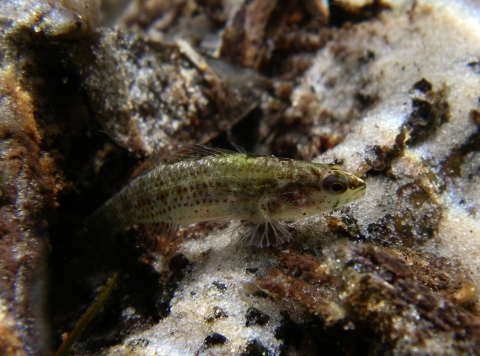Eglin Air Force Base, Fla. – The U.S. Fish and Wildlife Service is removing the Okaloosa darter from the federal list of Endangered and Threatened Wildlife. Long-term partnerships with federal, state, local and private citizens contributed to the recovery of the species, which was near the brink of extinction.
“This remarkable recovery story was made possible by our partners and the U.S. Air Force’s commitment to improving Okaloosa darter habitat on Eglin Air Force Base,” said acting Regional Director, Michael Oetker. “As we celebrate the Endangered Species Act’s 50th anniversary this year, this is a great example of how the military and the Service collaborate to achieve our respective missions.”
More than 90% of Okaloosa darters occupy six streams on land managed by Eglin Air Force Base. Since the fish was listed as endangered in 1973, habitat restoration efforts on 480 acres of land have reduced erosion into streams, removed barriers to fish passage fish passage
Fish passage is the ability of fish or other aquatic species to move freely throughout their life to find food, reproduce, and complete their natural migration cycles. Millions of barriers to fish passage across the country are fragmenting habitat and leading to species declines. The U.S. Fish and Wildlife Service's National Fish Passage Program is working to reconnect watersheds to benefit both wildlife and people.
Learn more about fish passage , and reconnected streams. A population that once numbered fewer than 10,000 fish has grown to more than 600,000 individuals.
"More than 30 years of best management practices and partnerships with the U.S. Fish and Wildlife Service, the Florida Fish and Wildlife Conservation Commission, and the efforts of many others led to the recovery of the Okaloosa darter," said Brig. Gen. Jeffrey Geraghty, 96th Test Wing commander. "We are grateful to everyone who brought this fish back from the brink of extinction to a thriving population on Eglin."
The Service listed the species as endangered in 1973. In 2011, the Service downlisted the Okaloosa darter from endangered to threatened. A five-year review was initiated in 2018, and a species status assessment report supported the decision to delist the species. A peer-reviewed summary details the fish’s current and historical status, population stability projections, and future trends. A post-delisting monitoring plan will ensure the fish remain healthy and secure from the risk of extinction.
Today’s announcement comes as the ESA turns 50 years old in 2023. Throughout the year, the Department of the Interior will celebrate the ESA’s importance in preventing imperiled species extinction, promoting wildlife recovery, and conserving the habitats they depend on. The ESA has been highly effective and credited with saving 99% of listed species from extinction. Thus far, more than 100 species of plants and animals have been delisted based on recovery or reclassified from endangered to threatened based on improved conservation status, and hundreds more species are stable or improving thanks to the collaborative actions of Tribes, federal agencies, state and local governments, conservation organizations and private citizens.
The final rule, post-delisting monitoring plan, species status assessment, and five-year review are available at http://www.regulations.gov under docket number FWS-R4-ES-2021-0036.
Learn more about the Okaloosa darter delisting in our Frequently Asked Questions.



